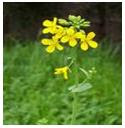main |
sidebar

 Mustard sprouts are a classic, quick to grow for a tasty salad with a spicy, peppery flavour. The name, "mustard", derives from the Latin word "mustum" which means "must".
Mustard sprouts are a classic, quick to grow for a tasty salad with a spicy, peppery flavour. The name, "mustard", derives from the Latin word "mustum" which means "must".
Culture
Pot Size 6" wide and 10"deep container.
Seed Spacing Broadcast seeds over the soil surface and cover lightly with soil.
Seed Germination 8 to 14 days.
Plant Spacing 15” to 18”
Preferred pH Range Will grow in soil with pH of no less than 6.0.
Soil Requirements Well drained and rich fertile.
Growing Mix Use a mix of about two parts potting soil to one part coarse sand or perlite.
Fertilizer Feed with fish/seaweed liquid fertilizer every month. Less fertilizing is needed in the winter.
Sun & Lighting Grows best in full sun, but tolerate light shade.
Water Requirements Water on a regular schedule but keep soil moist
Uses
 Pick mustard leaves to use for sautéing or stewing. Add leaves to stir-fries and salads. Mustard Greens add a nice, sharp flavor contrast to mild, buttery lettuces and therefore are often one of the plants found in mesclun mixes.
Pick mustard leaves to use for sautéing or stewing. Add leaves to stir-fries and salads. Mustard Greens add a nice, sharp flavor contrast to mild, buttery lettuces and therefore are often one of the plants found in mesclun mixes.
Related Articles:
How to grow medicinal herbs, cooking herbs and tea herbs indoors. Holistic guide about healing nature of herbs in your garden. Moon gardening Calendar, indoor garden kits and herb garden seeds.
LINKS
Video Wall
Followers
About Me

- Zoy
- Aurora, Canada
- Holistic lover, enjoy biodynamic gardening, natural life style and herbal medicine.
A mighty plant that’s highly prolific
 Mustard sprouts are a classic, quick to grow for a tasty salad with a spicy, peppery flavour. The name, "mustard", derives from the Latin word "mustum" which means "must".
Mustard sprouts are a classic, quick to grow for a tasty salad with a spicy, peppery flavour. The name, "mustard", derives from the Latin word "mustum" which means "must".
Wild Mustard (B. juncea) is thought to be native to Western Asia and Europe, but is now grown in many parts of the world. Recorded evidence of the use of mustard can be found dating back 7000 years in India and it is also believed to have been widely used in Africa and China perhaps even earlier. Mustard is an ordinary-looking little seed with an impressive ability to grow into a mighty plant that’s highly prolific. Its reputation as both a seed with great promise and great piquancy is supported by numerous passages found everywhere from the Bible to Shakespeare.
Mustard green are a tradition dish in the southern US. Their popularity is starting to spread, however. The mustard plant's leaves are good sources of calcium, vitamin A and vitamin C, and they are great added to a salad or used in cooking.
Culture
Pot Size 6" wide and 10"deep container.
Seed Spacing Broadcast seeds over the soil surface and cover lightly with soil.
Seed Germination 8 to 14 days.
Plant Spacing 15” to 18”
Preferred pH Range Will grow in soil with pH of no less than 6.0.
Soil Requirements Well drained and rich fertile.
Growing Mix Use a mix of about two parts potting soil to one part coarse sand or perlite.
Fertilizer Feed with fish/seaweed liquid fertilizer every month. Less fertilizing is needed in the winter.
Sun & Lighting Grows best in full sun, but tolerate light shade.
Water Requirements Water on a regular schedule but keep soil moist
Uses
 Pick mustard leaves to use for sautéing or stewing. Add leaves to stir-fries and salads. Mustard Greens add a nice, sharp flavor contrast to mild, buttery lettuces and therefore are often one of the plants found in mesclun mixes.
Pick mustard leaves to use for sautéing or stewing. Add leaves to stir-fries and salads. Mustard Greens add a nice, sharp flavor contrast to mild, buttery lettuces and therefore are often one of the plants found in mesclun mixes.
As heat destroys much of the flavour of mustard, it's always best to add it late on in the cooking. Stew leaves with bacon or a ham hock, southern-style, or shred and sauté them with other greens to make a bed for grilled fish and meats. You can also add mustard greens to long-cooking soups and stews. Flowers can be used as an edible garnish.
Over the years, mustard been called an appetite stimulant, a digestive aid, and a decongestant in folk medicine. Because mustard increases blood circulation, it’s often used in plaster form to treat inflammation. Due to the presence of mucilages, mustard has laxative effects.
Related Articles:
Subscribe to:
Post Comments (Atom)
Menu
Types of Herbs
Culinary Herbs
Medicinal Herbs
Tea Herbs
Template Design by SkinCorner | Template Image from Dapino-Graphics | Flowers images from yunphoto.net












2 comment.:
Gardening is my passion and i keep looking for any kind of updates and info regarding gardening. your blog seems to be full of relevant info that can serve the purpose for me in many ways. looking for more info in future.
kuşadası
milas
çeşme
bağcılar
urfa
24İPPN
Post a Comment